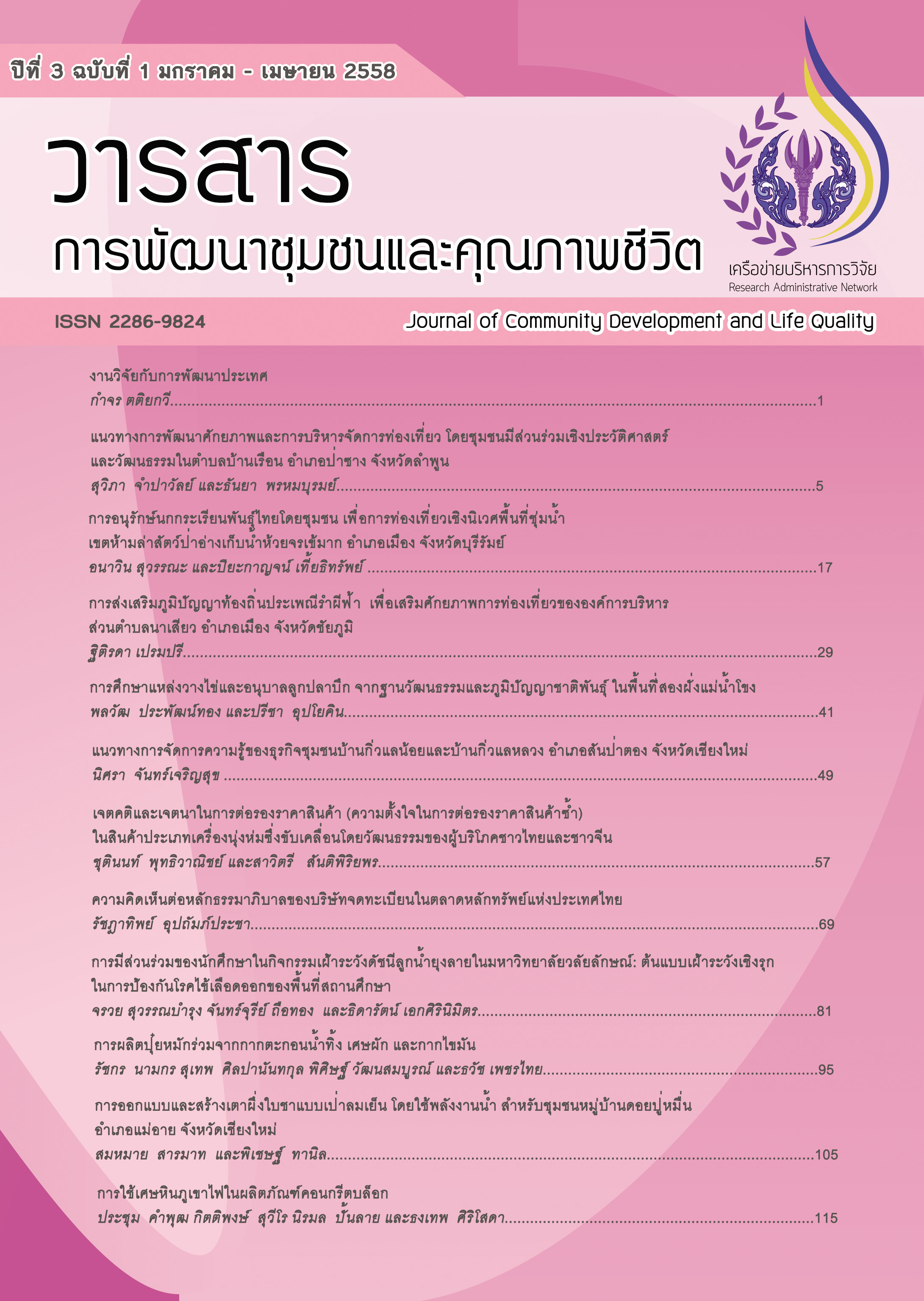เจตคติและเจตนาในการต่อรองราคาสินค้า (ความตั้งใจในการต่อรองราคาสินค้าซ้ำ) ในสินค้าประเภทเครื่องนุ่งห่มซึ่งขับเคลื่อนโดยวัฒนธรรมของผู้บริโภคชาวไทยและชาวจีน
Main Article Content
บทคัดย่อ
งานวิจัยชิ้นนี้มีจุดประสงค์ที่ศึกษาเจตคติและเจตนาในการต่อรองราคาสินค้า (ความตั้งใจในการต่อรองราคาสินค้าซ้ำ) ซึ่งขับเคลื่อนโดยวัฒนธรรมของผู้บริโภคชาวไทยและชาวจีนเมื่อซื้อสินค้าประเภทเครื่องนุ่งห่มการสำรวจจัดขึ้นที่ตลาดสินค้าประเภทเครื่องนุ่งห่มรายใหญ่ของไทย โดยคำนึงถึงสภาพแวดล้อมที่เอื้อต่อการต่อรองราคาสินค้า อาทิ ตลาดนัดสวนจตุจักร เซ็นเตอร์วัน เป็นต้น แบบสอบถามถูกแจกจ่าย โดยการเลือกตัวอย่างตามความสะดวกผลการศึกษาทั้งกลุ่มตัวอย่างลูกค้าชาวไทย 198 คน และลูกค้าชาวจีน 116 คน ที่ได้จากการวิเคราะห์สมการโครงสร้างชี้ชัดว่าเจตคติในการต่อรองราคาสินค้าของผู้บริโภคชาวไทยและชาวจีนส่งผลต่อเจตนาในการต่อรองราคาสินค้าและวัฒนธรรมส่งผลทั้งต่อ เจตคติและเจตนาในการต่อรองราคาสินค้าสำหรับการประยุกต์ใช้ในทางการจัดการและการตลาดนั้น พบว่าในภาวะที่บริษัทต่างชาติต่างมีการขยายตัวและบริษัทในภาคพื้นเอเชียแปซิฟิกเตรียมจะเป็นบริษัทข้ามชาติเต็มตัวด้วยการส่งออกไปต่างประเทศอย่างต่อเนื่อง ดังนั้นหากร้านขายสินค้าประเภทเครื่องนุ่งห่มสามารถยืดหยุ่นราคาสินค้าที่ตั้งไปตอนแรกได้จะเพิ่มโอกาสที่จะเป็นผู้ชนะในการต่อรองราคาสินค้า ทั้งนี้เมื่อพิจารณาถึงข้อจำกัดในงานวิจัยชิ้นนี้ ผู้เขียนพบว่าตัวงานวิจัยมิได้รวมเรื่องอายุของกลุ่มผู้บริโภคเป็นปัจจัยที่ขับเคลื่อนเจตคติและเจตนาในการต่อรองราคาสินค้าดังนั้นสาเหตุนี้อาจส่งผลต่อการประยุกต์ใช้ผลวิจัยในวงกว้างได้ส่วนงานวิจัยในอนาคต ผู้เขียนชี้แนะให้นักวิจัยท่านอื่น ๆ ศึกษาในเชิงเปรียบเทียบระหว่างหลาย ๆ ประเทศเพื่อหาผลวิจัยที่แสดงถึงนัยสำคัญต่าง ๆ
Article Details
กองบรรณาธิการขอสงวนสิทธิ์ในการตรวจและแก้ไขบทความที่เสนอเพื่อตีพิมพ์ในวารสารการพัฒนาชุมชนและคุณภาพชีวิต
บทความหรือข้อความคิดเห็นใด ๆ ที่ปรากฏในวารสารการพัฒนาชุมชนและคุณภาพชีวิต เป็นวรรณกรรมของผู้เขียนโดยเฉพาะคณะผู้จัดทำไม่จำเป็นต้องเห็นด้วย และไม่ใช่ความรับผิดชอบของมหาวิทยาลัยและคณะผู้จัดทำ / บรรณาธิการ
เอกสารอ้างอิง
Campbell, N. C. G., J. L. Graham, A. Jolibert and H. G. Meissner. 1988. Marketing negotiations in France, Germany, the United Kingdom, and the United States. Journal of Marketing 52: 49–62.
Chen, M. 1995. Asian Management Systems: Chinese, Japanese and Korean Styles of Business. Thomson Business Press, London, UK.
Engholm, C. 1991. When Business East Meets Business West: The Guide to Practice and Protocol in the Pacific Rim. John Wiley & Sons, New York, NY.
Euromonitor International. 2013. Apparel in Thailand. (Online). Available: http://www.euromonitor. com/apparel-in-thailand/report (November 5, 2013).
Herrmann, G.M. 2004. Haggling spoken here: Gender, class, and style in US garage sale bargaining. Journal of Popular Culture 38: 55–81.
Johnston, W. J. and T. V. Bonoma. 1984. The effect of power difference on the outcome of consumer bargaining situations. Advances in Consumer Research 11: 170–174.
Kwon, K. N., D. W. Schumannand and A. Fairhurst. 2010. Consideration of an expected future deal in assessing the value of a present deal: Forward-looking bargain shopping. Journal of Business Research 63: 84–90.
Lee, D.Y. 2000. Retail bargaining behavior of American and Chinese customers. European Journal of Marketing 34: 190–206.
Maxwell, S., P. Nye and N. Maxwell. 2003. The wrath of the fairness-primed negotiator when the reciprocity norm is violated. Journal of Business Research 56: 399–409.
Meng, J. and S. A. Nasco. 2009. Cross-cultural equivalence of price perceptions across American, Chinese, and Japanese consumers. Journal of Product and Brand Management 18: 506–516.
Nunnally, J. C. and I. H. Bernstein. 1994. Psychometric Theory. McGraw-Hill, New York, NY.
Nuttavuthisit, K. 2011. Consumption and Marketing: The Asian Perspectives and Practices. Sasin Graduate Institute of Business Administration of Chulalongkorn University, Bangkok, Thailand.
Osman-Gani, A. A. and J.-S Tan. 2002. Influence of culture on negotiation styles of Asian managers: An empirical study of major cultural/ethnic groups in Singapore. Thunderbird International Business Review 44: 819–839.
Patton, C. and P.V.S Balakrishnan. 2010. The impact of expectation of future negotiation interaction on bargaining processes and outcomes. Journal of Business Research: 63, 809–16.
Puncreobutr, V. 2014. Professional and cross-cultural competences of Thai graduates to work in ASEAN context. Journal of Community Development and Life Quality 2(3): 225–232.
Simonson, A. 1991. Examining consumer losses and dissatisfaction due to broken sales and service agreements. Journal of Consumer Satisfaction Dissatisfaction and Complaining Behavior 4: 50–61.
Stroeker, N. and G. Antonides. 1997. The process of reaching an agreement in second-hand markets for consumer durables. Journal of Economic Psychology 18: 341–367.
Swierczek, F. W. 1990. Culture and negotiation in the Asian context: Key issues in the marketing of technology. Journal of Managerial Psychology 5: 17–24.
Thai Trade Center, North America. 2011. Thai textile and apparel industry. (Online). Available: http://www.thaitradeusa.com/home/?page_id=2081 (November 5, 2012).
Tung, R. 1984. How to negotiate with Japanese. California Management Review 26: 62–77.
Vieregge, M. and S. Quick. 2011. Cross-cultural negotiations revisited: Are Asian generations X and Y members negotiating like their elders? Cross Cultural Management: An International Journal 18: 313–326.
White, S. B. and M. A. Neale. 1994. The role of negotiator aspirations and settlement expectancies in bargaining outcomes. Organizational Behavior and Human Decision Processes 57: 303–317.


